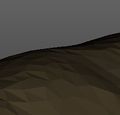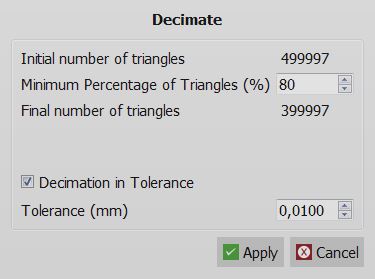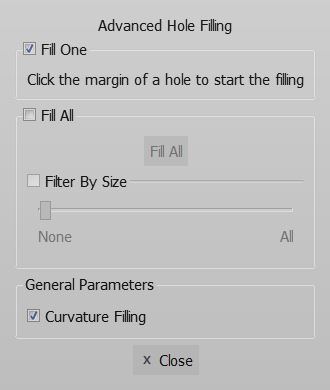Difference between revisions of "Man MeshEditing/pt-br"
(Created page with "A malha gerada pode ter artefatos, ruídos ou buracos que precisam ser corrigidos.") |
(Created page with "OpticalRevEng Dental já aplica uma estratégia específica de geração de malhas para cada elemento, tentando corrigir automaticamente todos os problemas. No entanto, pode h...") |
||
| Line 7: | Line 7: | ||
A malha gerada pode ter artefatos, ruídos ou buracos que precisam ser corrigidos. | A malha gerada pode ter artefatos, ruídos ou buracos que precisam ser corrigidos. | ||
| − | OpticalRevEng Dental | + | OpticalRevEng Dental já aplica uma estratégia específica de geração de malhas para cada elemento, tentando corrigir automaticamente todos os problemas. No entanto, pode haver a necessidade de editar mais as malhas antes de exportá-los para outro software. |
In this page, there is a description of the Mesh Editing tools that can be found in the [[Support_Toolbars_And_Menus|Mesh Menu and Mesh Toolbar]]. | In this page, there is a description of the Mesh Editing tools that can be found in the [[Support_Toolbars_And_Menus|Mesh Menu and Mesh Toolbar]]. | ||
Revision as of 18:57, 28 September 2015
Contents
Edição de Malhas
Ao gerar uma malha a partir dos dados adquiridos por um escaner, as malhas não pode ser perfeitas para o uso designado.
A malha gerada pode ter artefatos, ruídos ou buracos que precisam ser corrigidos.
OpticalRevEng Dental já aplica uma estratégia específica de geração de malhas para cada elemento, tentando corrigir automaticamente todos os problemas. No entanto, pode haver a necessidade de editar mais as malhas antes de exportá-los para outro software.
In this page, there is a description of the Mesh Editing tools that can be found in the Mesh Menu and Mesh Toolbar.
Remove Spikes
A spike in a mesh is defined as a tiny part of the surface that is not actually part of the 3D object acquired by the scanner.
Usually, these spikes are automatically corrected by the software during the mesh generation but, if the meshes have been imported from another system, some spikes could be present.
This tool automatically removes all the spikes and repairs the mesh.
Mesh Sharpening
The sharpening tool carries out two actions. It smooths the parts of the surface that are more planar and, at the same time, it sharpens the edges. It takes 2 parameters:
- T [°] : this angle identifies what an edge is. All the parts of the surface that have an angle smaller than T° will be sharpened. When this value is at 0, all the surfacse will be smoothed
- Normal Iterations : how many times the software will pass over the surface to carry out the sharpening. Bigger values mean more smoothing and more sharpening
The software applies this tool automatically, using specific parameters. The use of this tool with the wrong parameters may modify the shape and the dimension of the objects.
Mesh Smooth
This tool is similar to the Mesh Sharpening one but it applies a smoothing to the whole surface, without preserving the edges.
The software applies this tool automatically, using specific parameters. The use of this tool with wrong parameters may modify the shape and the dimension of the objects.
Mesh Decimate
This tool reduces the number of triangles in a mesh, to save more space, trying to save as much detail as possible.
On the top, the current number of triangles of the selected meshes is specified.
It is possible to insert a percentage of triangles to be kept (For example 50% to halve the mesh size).
It is also possible to establish a tolerance value. If the tolerance is enabled, the software will stop the decimation if this will modify the mesh more than the tolerance parameter.
Just click on Apply to see the result.
Mesh Defeature
This tool takes a selection of the mesh and it removes all the details, leaving the surface as plane as possible. It removes holes, spikes, noises. To use this tool:
- Select the area in which it is necessary to remove all the features with the Selection Tools
- Apply the Mesh Defeature
Make Manifold
This tool takes a mesh and then looks for and removes the parts of the surface that are not Manifold. Look at: definition
Mesh Catenate
This tool can be used only in Free Mode. It takes all the selected meshes and creates a single mesh, merging all of the selected meshes together.
Flip Normals
Every mesh has an inside and an outside. The software gives them two different colors. This tool flips the inside and the outside of the selected meshes.
Detect Intersections
Sometimes, it is possible that part of the surface of a mesh is intersected with the mesh itself, something that in reality is not possibile. This tool identifies this situation and fixes it.
Fill All Holes
This is an interactive tool that allows to fill the holes in the currently selected mesh.
This tool can work in 2 different ways
Fill One
In the fill one mode, the software will highlight the hole near the mouse cursor, and by clicking with the left mouse button on the highlighted hole, the sofware will fill it.
Fill All
In the fill all mode, the software will try to close all the holes. With the Filter By Size function, it is possible to select all the holes below one size and fill them. The selected holes will be highlighted in real time by the sofware.
Curvature Filling
There is an additional option: curvature filling. If this option is enabled, the software will try to follow the curvature of the rest of the surface, closing the hole. If it's disabled, the software will ignore the rest of the surface and close the hole with a straight plane.
Close Denture
When scanning an entire jaw, there will be a big hole at the base. This tool has been created to close only that hole. Closing that hole with the Fill All Holes tool takes a lot of time and the final result will not be good enough.
With the close denture tool, the mesh will be closed with a perfect plane in a reduced amount of time.
This tool will not work if the mesh has other holes or artefacts.
Mesh Cleaning
This tool takes a mesh and tries to remove all the possible artefacts and problems.
Mesh Offset
This tool creates a bigger/smaller version of the selected mesh. The Offset [mm] parameter allows to select how much the mesh will change.
The three flags (Remesh, Sharpen and Optimize Vertices) have to be checked.
Usually, none of these tools is necessary to work because the strategies already apply a selected sequence of specific tools to each element.






